Hydrangeas are one of those iconic flowers that everyone loves. From lining a driveway to in front of commercial buildings, you can find Hydrangeas anywhere. But, where is the best place to plant a Hydrangea? We grow accustom to see them in many different settings that it might be hard to know which is best for planting in your own garden. The Grow Monster has more than a couple Hydrangea and not only are they easy to care for but will bloom all through fall if planted in the right location.
Where is the best place to plant a Hydrangea? Hydrangeas do best in well-draining soil with morning sun and less direct afternoon sun the more South you are.
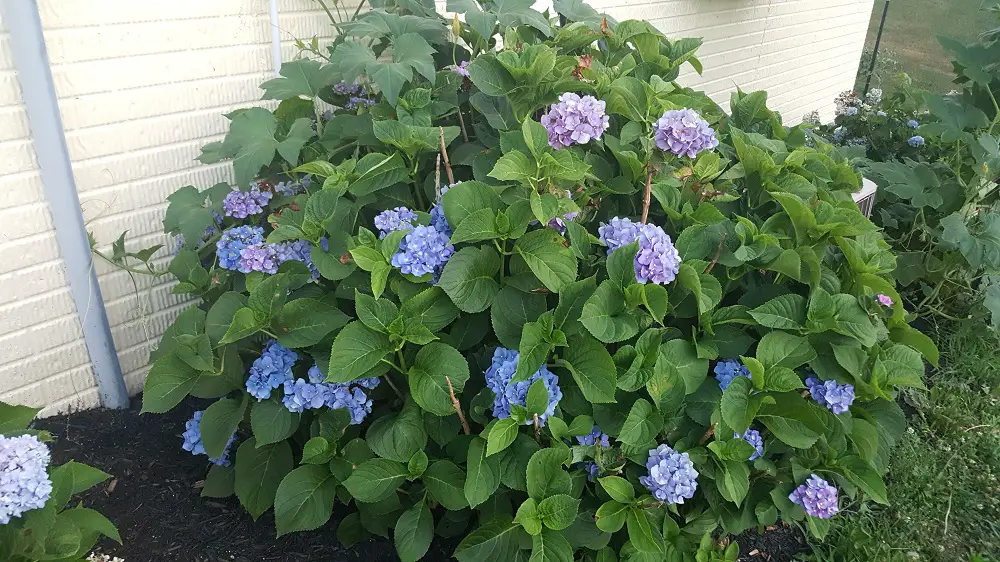
Knowing that Hydrangeas prefer morning sun and don’t do well in long hours of direct afternoon sun will help you choose the best location to plant a Hydrangea shrub. Hydrangeas need enough water to keep their soil moist but it must be well-draining so their roots are not sitting in water. Read on to learn more about where is the best place to plant a Hydrangea in your garden.
Where is the Best Place to Plant a Hydrangea?
The first thing you need to figure out when asking yourself where is the best place to plant a Hydrangea is which direction the sun moves across your property during the day. What area of your house gets morning sun, which area gets afternoon sun, where is it shady most of the day or part of the day? These questions are important because Hydrangeas prefer morning sun and shorter periods of direct afternoon sun the further south you are.
Hydrangeas are hardy in zones 5b-9a, and can thrive in zone 8 and 9a with lots of watering during the hot summer months and attention to sun exposure. You can check out which growing zone you are in on the USDA plant hardiness zone map below. If you know which zone you are located and which areas of your home get which type of sun exposure, you will be better able to plant a Hydrangea in the best place for your area. The lower your growing zone number, the more afternoon sun your Hydrangea can receive.
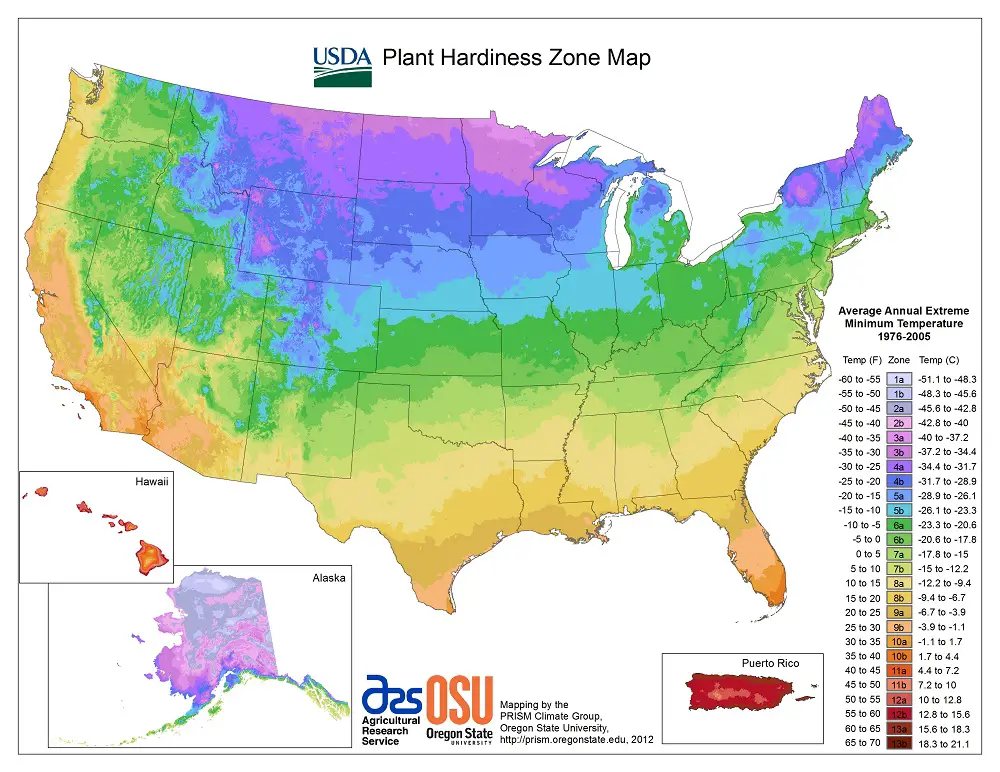
Once you know which area of your garden receives morning sun, or might be a partially shaded spot in direct afternoon sunlight, you are ready to place your Hydrangea in the garden. You will need to dig a hole that is twice as wide in diameter as your Hydrangea root ball and just about as deep as the root ball is high. It is important to make sure that you do not bury the Hydrangea deeper than the current dirt line. You can choose to water your root ball before planting so the soil around the roots is moist.
Before you lower the Hydrangea in to the hole, add some compost and also water the hole thoroughly. It is important to make sure that the ground will have enough moisture to help the Hydrangea to recover from planting it in a new location. As you lower the Hydrangea take care to make sure the dirt does not go higher than it was in the container, that could cause water to pool around the base of the plant leading to root rot. Hydrangeas do not like to sit in watery soil, they prefer a moist well-draining soil.
Since Hydrangeas prefer a moist well-draining soil, make sure the are you are planting them either already has this soil or you fill the hole you are putting the plant in with this type of soil. If you have a thick clay soil, you will have to amend it with compost so that it will not retain too much moisture leading to root rot in your Hydrangea. The Grow Monster lives in an area with clay soil that doesn’t drain very well, so we add lots of compost to help maintain good well-draining soil for our plants. If you’d like to read more about the different ways to compost check out this article here.
Once you have added enough soil so that your Hydrangea is planted firmly in the hole, make sure to water it in deeply. Spring is the best time to plant a Hydrangea, but if you are planting it later in the Spring or in summer you will need to watch that the soil remains moist to help your Hydrangea establish itself in this location. Planting in the correct area with the correct amount of sunlight will go a long way to ensure your Hydrangea will bloom beautifully for years to come. We like to add a layer of mulch to help maintain soil moisture in our garden.
How Far Apart to Plant Hydrangeas?
Now that you’ve planted one Hydrangea, maybe you’d like to plant a row of them along your driveway, the side of your house, or even as a hedge along your property. You will need to ensure you plant a Hydrangea at the proper spacing from each other so they can grow filled with blooms. When planting multiple Hydrangeas, you want to be aware of what type you are planting and how large that variety will grow. For example, if you are planting a Bigleaf Hydrangea, they can grow as tall as 10 ft and as wide as 10 ft.
Your Hydrangeas will grow quickly if planted in the correct location for your area and can fill out a space over the course of one year, so it is important to make sure you space multiple Hydrangea correctly. Once you know how wide your plant will grow, you will want to distance each plant that estimated width apart from the center of their root ball. So, for example, if the Bigleaf variety you have will grow 10 ft wide, then you will need to space your plants 10 feet apart between root balls.
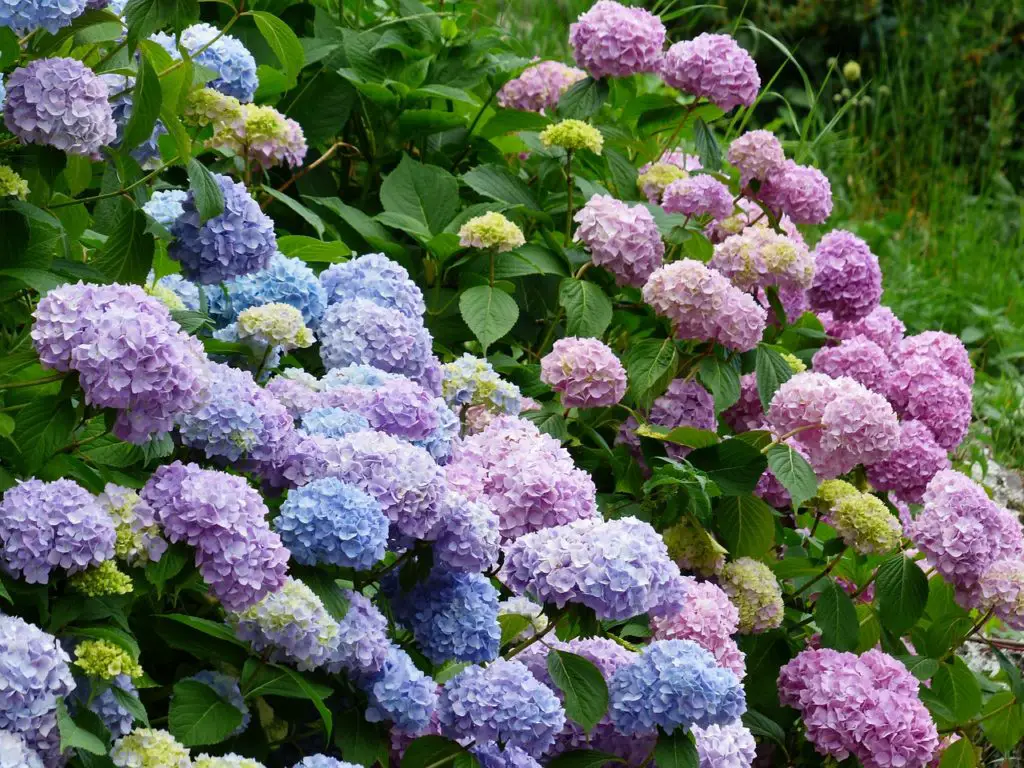
The reason you use the root ball as a reference point is because the root ball should end up relatively centered in the plant growth. You can also take in to account pruning your Hydrangea if you know you will want them closer together, but must remember to prune your Hydrangeas correctly and at the right time of year for their variety. For the most part, Hydrangeas will grow well by themselves with minimal care so spacing them correctly from the beginning will ensure you have a beautiful area of your garden each spring through fall when they are in bloom.
What Pairs Well with Hydrangeas?
When planning your gardening space for Hydrangeas, you might ask what pairs well with Hydrangeas. Thinking about the area that is best to plant a Hydrangea, you can figure out which plants would make good companions for Hydrangeas. You will need to plant other flowers, shrubs and trees that prefer morning sun or a shadier afternoon sun location. Or, if you live in a colder growing zone, you may be able to plant your Hydrangeas in a spot that gets more afternoon sun and you’d need to think about what plants also like that much direct sunlight.
You should also take in to account the color your Hydrangea blooms will be. Hydrangeas come in a variety of shade from white, blue, purple, pink, red, and green. You can also change the color of the blooms on some varieties based on the pH of the soil. If you have a white flowering Hydrangea, you may not want to place other white flowers in the same area. You should also think about the color of your home if your Hydrangea shrubs are placed near your house. If you have a blue home, you may want to contract that with white Hydrangea flowers and some sort of low flowering bush or an evergreen between shrubs.

Some great options to pair with your Hydrangea are Hosta plants because they will grow lower than the Hydrangea and also like the morning sun to partial shade areas of your garden. Azaleas and Rhododendron are also great options that will bloom first and then have great foliage to compliment the blooms of your Hydrangea. They will also bloom first so your area will have flowers all spring through fall.
You may also want to pair your Hydrangea shrubs with shorter Boxwoods or other evergreen varieties. You may alternatively want to have the Hydrangeas in front of taller Boxwoods or even a Crape Myrtle centered behind several Hydrangeas surrounded with Boxwoods. It is great to think of your garden space in layers and what will be flowering when throughout the year to plan a beautiful spot you will enjoy.
Here’s a few sample ideas for garden spaces you can create with your Hydrangea and other plants. Grow the Hydrangeas as a border along your driveway with the Hostas closer to the pavement. If you have a smaller space, the Hydrangea can be a focus point in the center with Hostas surrounding it. You could also choose to plant a few Hostas on a terraced hill with Crape Myrtle behind and a Japanese Maple to the side surrounded with Coral Bells and Hostas. The various shades of green and burgundy along with either a red or white Hydrangea can really brighten up an otherwise shady area of your garden.

Do Hydrangeas Need a Lot of Water?
Hydrangeas need a fair amount of water, their name suggests. Hydr- and -angeas are derived from the Greek meaning “water vessel.” When you first plant a Hydrangea, you will need to make sure to water it in deeply. If you plant a Hydrangea in the hotter summer months, and the more direct afternoon sun your Hydrangea will need more water than if it is in a spot that gets morning sun or partial shade.
An important thing to remember about the water needs of the Hydrangea plant is that while they do need a lot of water, the plants do not like to be in soggy soil. If you over-water your Hydrangea or get very heavy rains and your soil is not well-draining then you will need to watch your plant for signs of root rot. Some of the signs of root rot are yellowing of leaves, the Hydrangea plant wilting and leaves starting to turn brown, and the stems might start to turn brown and get mushy. If you notice this happening to your Hydrangea there are a few steps to mitigate it.
The first thing to do if you start to see signs of root rot is to cut off any of the affected parts of the plant. Cut off the brown leaves, mushy stems, and check the roots to make sure the plant is not too far gone. While a Hydrangea can recover from root rot, time is of the essence. Add compost, mulch, wood chips to your soil- anything that can help the soil become better draining. You might even need to move the Hydrangea to another area of your garden if there is just too much standing water keeping the soil sopping wet.
Overall, making sure that you plant your Hydrangea in the right type of soil from the beginning is the best way to ensure it may not encounter root rot. Make sure your plant is well-watered but not over-watered so that the plant can take in the amount of water it needs without threat of disease and root rot. While watering your Hydrangea, take care not to water from above but below where you will not soak the leaves. This is especially true for Hydrangeas that might be located in a place with direct afternoon sun.
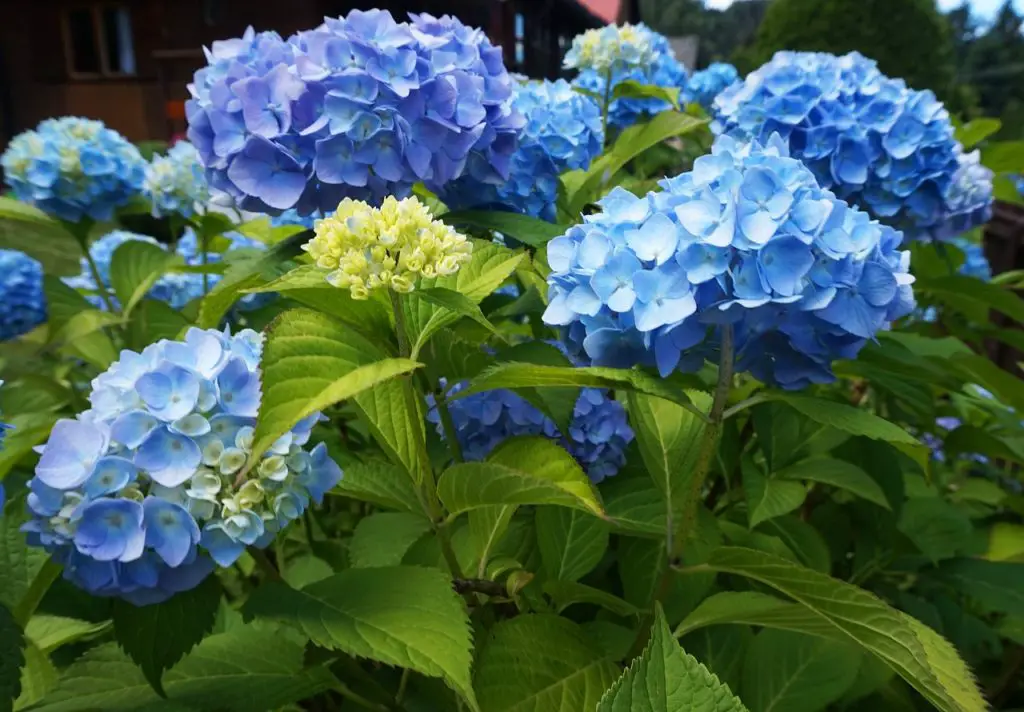
How Far From the House Should I Plant Hydrangeas?
Hydrangeas look beautiful along the side of a house or in front to give a welcoming site to visitors. They create a beautiful border and many people want to plant them right next to their homes. It is important to figure out how far from the house to plant Hydrangeas in order to avoid some issues in the future. The Hydrangeas will grow a certain width and height depending on which type and variety they are. Keep that in mind when planning your garden.
Think about how wide the Hydrangea will be and divide that number in half. Similar to figuring out how far apart to plant Hydrangeas, you will want to know the distance from the root ball that the plant will spread. You can then plant the Hydrangea knowing that it will not grow up against your home, brushing against siding or brick or scraping fences and porches. A good rule of thumb is to add a little extra just to make sure there is space between the widest part of the plant and your home.
Hydrangeas are known to have shallow roots about 6-8 inches and only about 6 inches down. Because of this, they are great candidates to plant next to your home because you won’t have to worry about the roots encroaching on your foundation. Since they do have shallow roots, you will want to mulch the area where you plant them to help maintain moisture in the soil throughout the day.
Do Hydrangeas Grow Well in Pots?
Hydrangeas can grow well in pots if you keep a few things in mind. First, you need to have a large enough container for your Hydrangea. Second, your container needs to have well-draining soil. Third, your container needs to be in a location that gets adequate sunlight- morning sun is preferred to plant a Hydrangea in a pot.

Choose a container that is large enough for your Hydrangea. You want to consider how wide the variety will get and how tall it may be. Your container needs to be able to accommodate the roots of the plant while also being able to anchor the plant down so it doesn’t fall. A good measure is to use a container at least twice the size of the Hydrangea root ball. This way, you allow for any additional growth and make sure the plant will not be considered root bound in its new container.
Once you have chosen your pot, ensure that it contains well-draining soil and has hole in the bottom for drainage. Hydrangeas like moist soil but do not want to sit in soggy soil. Container plants need to be watered much more often than those in the ground, so be sure to water your Hydrangea about 3 times per week. Water thoroughly and be mindful not to over-water your plants.

Once you have your pots in containers with well-draining soil you will need to choose a location that gets adequate light for your Hydrangea. Since plants in pots are more prone to dry out, you will want to ensure your Hydrangea is not in direct afternoon sun even if you are in a cooler growing zone. Your Hydrangeas in containers would look beautiful on a patio or deck or even a front porch depending on where the morning sun is in your garden. You may even want to place your potted Hydrangea indoors.
Final Thoughts
If you are going to plant a Hydrangea remember the best place to plant Hydrangeas is in well-draining soil that gets morning sun. If you live in a cooler growing zone, you are able to plant a Hydrangea in some direct afternoon sunlight as long as you monitor the soil moisture. Hydrangeas are great plants to use as a border, around your porch, as a focal point in your garden, or even in a pot on your patio. This versatile blooming beauty is relatively low maintenance and would be a great addition to any garden!

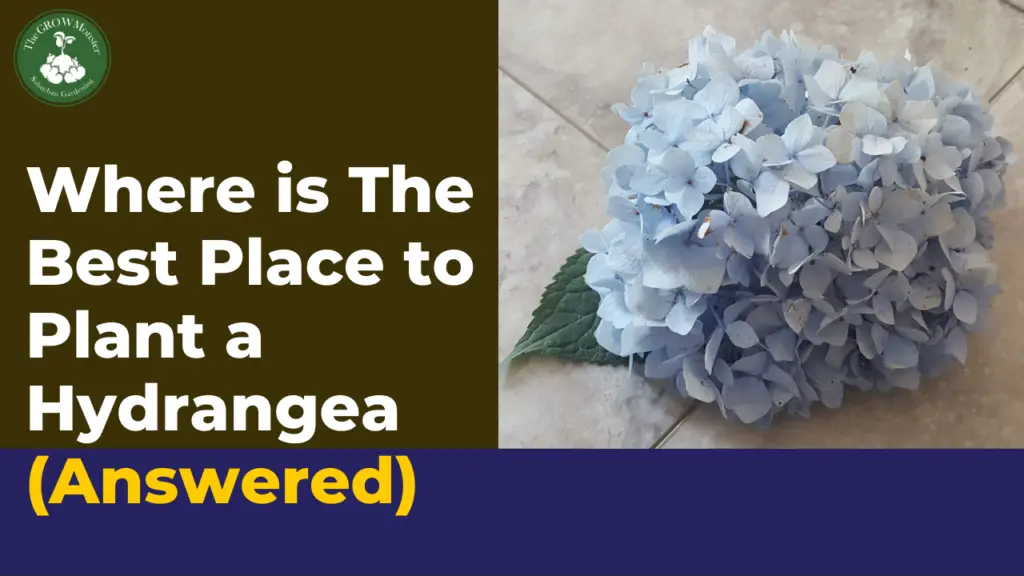
Pingback: How Much Sun do Hydrangeas Need? - The Grow Monster